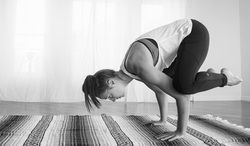
Well, guess what, real health isn't painful. And fitness is definitely an important part of health - but it shouldn't be one that causes pain. If it does, you really need to read today's post, and the article mentioned below as well.
I can tell you a bit about workouts that push you to the limit. And I can certainly tell you a lot about pain. But first, let me tell you why, this year, I gave up my favorite yoga workout - and why I don't feel bad about it...
The workout was hard - just borderline too hard, but not quite. Just hard enough to leave me a sweating, trembling, triumphant mess when finished, but I always made it through (barely) the whole 30 minute workout. I was obsessed! I loved it! I sometimes hated it at the same time! I did Yoga Meltdown several times per week. I celebrated the relatively easy Sun Salutations, and Warrior II, knowing what was coming. I muscled through the Chaturanga Pushups, challenging myself to get off my knees and try adding another one of the "full" versions every week or so. I reveled in the agony of Locust, and the final panting push through two sets of Dolphin at the very end. It was amazing! I was hooked. I tried a couple of other yoga DVDs as well, and enjoyed some of them. But Yoga Meltdown was my go-to for well over a year.
Then I got busy and started slacking off on my workout routine. A month or two went by without Yoga Meltdown. I stopped doing my back exercises regularly as well. Then one weekend, it happened. Too many hours standing in high heels, preceded by too many months of not working out enough, and I was down for the count. I suffered a month of the worst back pain of my life. For two weeks, I could barely walk, drive, or even dress myself. Even the gentlest stretches seemed out of the question. With many chiropractic visits, and stretching and back exercises every hour or so, I began the long road to recovery.
Yoga Meltdown languished on my DVD shelf for 6 months, then 9. Probably a year or so went by before I even looked at it again.
In the meantime, someone gave me one of Ana Brett and Ravi Singh's DVDs as a gift, introducing me to a new form of yoga I had barely even heard of before: Kundalini Yoga.
For the novice yoga practitioner, it is somewhat hard to describe how different this form of yoga is from the typical Westernized Hatha version. I usually just say something like, "it focuses more on breathing," which is true, but only a tiny fraction of the truth.
Kundalini, for me, is what I imagine yoga was originally meant to be. It engages your entire body, mind, and spirit into one united whole. Breathing, meditation, and physical movement become one thing. Literally. Each pose is a meditation in itself. Each breath is a physical exercise. Each workout is a revelation, from which I emerge refreshed, energized, relaxed, and awake. Not drenched in sweat (although sweat happens sometimes), not breathless, although it certainly provides a cardiovascular workout, and not limp with exhaustion, though often pleasantly relaxed.
Kundalini yoga became part of my religion - literally. When engaged in a Kundalini workout, I felt my entire being was communicating with God. I began collecting Ravi & Ana DVDs like it was my job. I believe I am now up to 8! :-)
So what happened to "Yoga Meltdown"? Well, I tried it a few more times, but my heart wasn't really in it. The first, time, I wasn't even sure I would be able to do it. I hadn't done it in over a year, and figured I would be out of practice with many of the exercises. In fact, I actually kept up quite well, and completed the whole thing. But it wasn't fun. I made myself do it once in a while anyway, just because I figured it was "good for me" to get a really intense workout from time to time. But I didn't enjoy it.
The last time I did it was just a few months ago - maybe February. I convinced myself I was in the mood for a more challenging workout, and I should revisit Yoga Meltdown. It was the same as before - the sweating, shaking, exhaustion, that limp, wrung-out feeling, soreness that lasted for days.
I hated it.
And now, I had something to contrast it to. The invigorating, uplifting, energizing nature of Kundalini yoga was where I belonged.
And I put Yoga Meltdown back on the shelf for the last time. "I'm too old for this," I muttered, as I made my shaky way down the stairs. "From now on, I'm only doing workouts I love."
It was a decision that was liberating, and relatively guilt-free. But reading an article last week from one of my favorite authors about health and spiritual traditions put my last doubts to rest. The article was titled, "Maximum Effort, Maximum Damage: The Difference Between Health and Fitness."
In it, Dr. Simeon Roger (who takes a lot of tips from the Eastern traditions) discusses the unhealthiness of our fitness culture, which emphasizes visible results over health, gain over pain, and maximum intensity of effort, regardless of cost. (I do actually enjoy some forms of HIIT (high-intensity interval training), and there is some evidence that this is a natural way to exercise that maximizes your body's function and health. However, the best kind of this training is done for very short duration (15 minute sessions or less), and is less taxing on your body than most longer form endurance workouts.)
In general, I very much agree with Dr. Roger's assessment of imbalance in many of today's fitness programs.
These are the hallmarks of the Western approach to strength, which always tries to overcome the body with the mind. Over the millennia, humans have performed certain kinds of tasks for which our bodies are optimised- namely, slow, painstaking tasks that require us to sustain about 70% of effort by their nature. Hunting, gathering, farming, carpentry. Our burst capacity is for emergencies, not everyday use. That’s what we’re set up for.
If our approach to training ignores the balance of human nature, something will give. For every action, there is a reaction. For every over-extension, there is a collapse. That is the most fundamental difference between the (Eastern) approach and the others. One respects the way the human organism is set up. The other works against it. But nature always wins.
Dr. Roger explains health in the Eastern Taoist tradition in this manner, which really resonates with my definition of health as well:
- your body is able to move painlessly through its whole natural range of motion
- you are free from chronic illness, injury or pain
- you have a healthy back, joints and connective tissue
- you have high vitality due to a healthy emotional life, lack of tension in the body and free circulation of life energy
- the resting state of your muscles and nervous system is completely relaxed
So go! Be free of all mind-numbing, energy-sapping, body-torturing workouts! I give you permission to donate (or recycle) all your old workout DVDs that left you gasping on the floor in a puddle of sweat.
Instead, embrace exercise that feeds your body, mind, and soul with energy, inspiration, and health-bestowing movement. Love your workout, and let your workout love you back. As a result, health will blossom naturally. And you won't have to curse at your TV anymore. :-)
To your health,
Rose.



 RSS Feed
RSS Feed